Lime Mortar Vs. Cement Mortar: What Are The Major Differences?

Mortar is the material that is solely responsible for holding brick, stone, and other masonry units together. As such, it plays a vital role in the overall stability of a structure. Nowadays, there are four main types of mortar – N, O, S, and M – each of which is comprised of a distinct ratio of lime, cement, and sand. However, there are two discrepancies that you should also be aware of: lime mortar vs. cement mortar.
Lime mortar has been used in construction for thousands of years. Although it’s not as common today, it is still a strong, durable type of mortar that can reduce environmental impact and enhance the structural integrity of the home. Cement mortar, on the other hand, is often preferred when a quicker curing time is needed.
Regardless, if you are restoring a building, it’s important that you choose the right type of mortar. Using the wrong replacement mortar can cause more harm than good, and may have a negative impact on the stability of the entire structure. With that said, let’s explore what exactly lime mortar and cement mortar are, the differences between the two, and how to know which one to choose.
Do You Need Concrete, Brick, or Stone Pros?
Get free, zero-commitment quotes from pro contractors near you.

What is Lime Mortar?
Lime mortar has been in use since biblical times – it was even used to plaster the ancient pyramids in Egypt. It consists of lime (hydraulic or non-hydraulic), water, and an aggregate, like sand. Nowadays, lime mortar is mostly used in the conservation of old structures or the recreation of new buildings using traditional techniques.
The slaked lime that is used to make lime mortar is formed by cooking limestone rocks at 1,650 degrees Fahrenheit. During this process, the heat burns off the carbon dioxide found in the rock and leaves behind calcium oxide, or quicklime. This powdery quicklime is then submerged in water for weeks or months at a time to result in a lime putty known as “slaked” lime. The slaked lime is combined with water and sand (or other aggregates) to create the lime mortar.
When the lime mortar is exposed to air, it takes the carbon dioxide and releases water to return to its original limestone state. Lime mortar was used exclusively for masonry structures until the invention of Portland cement in the 19th century.
What is Cement Mortar?
Developed in 1824, cement mortar, or Portland cement, is a combination of calcined hard limestone and clay that is heated a second time. When compared to lime, Portland cement had the ability to attain much quicker setting times. Though its long terms strength is lower than natural elements, cement mortar has a quick initial strength that made it ideal for use during the Industrial Revolution. Because of its high strength and quick set time, lime mortars were almost completely phased out by the mid-20th-century.
Lime Mortar vs. Cement Mortar
If you are restoring a building that was constructed before the 1930s, it’s important that you choose the correct mortar to prevent spalling bricks. Overall, the mortar that you use should always be softer than the brick it is paired with. The more Portland cement that is added to a mortar, the harder it is, and the more potential for damage to the brick.
Physical Properties
Lime mortar hardens at a slower rate when compared to cement mortars, which makes it easier to work with. Cement mortar tends to be more brittle and prone to cracking, especially as a structure settles. Over time, it may need repairing. Whereas, cracked areas that occur in lime mortar can absorb carbon dioxide and mend themselves over time.
Although cement dries and hardens very quickly, it may be too strong for some applications – like when working with older bricks.
Vapor Barrier
Lime is breathable, which allows vapors to pass through and can help reduce moisture, while improving the home environment. Cement mortar, on the other hand, forms a water-resistant barrier that does not allow vapors to escape. It can also absorb water and cause moisture to collect, particularly in basements.
Environmental Concerns
When lime is produced it releases carbon dioxide in the atmosphere, while lime mortar absorbs carbon dioxide from the atmosphere over the course of its life. For this reason, environmentalists consider lime mortar to be “carbon neutral.” Cement production, in contrast, contributes substantially to global warming, as it releases a significant amount of carbon dioxide during production.
Lime Mortar and Cement Mortar Pros and Cons
The table below outlines the various pros and cons associated with these two distinct types of mortars:
| Lime Mortar Pros | Lime Mortar Cons | Cement Mortar Pros | Cement Mortar Cons |
| Permeability | Slower set time | High strength | No flexibility |
| Workability | Lower strength | Quick set Time | Impermeable to water |
| Flexibility | Expensive | Sets underwater | Not eco-friendly |
| Better for the Environment | More affordable | High strength* | |
| Heals itself |
*Note: Depending on the application, the higher strength of cement mortar can be an advantage or a disadvantage.
Which Mortar Should I Use?
If the structure was built using lime mortar, it is crucial that you replace damaged sections with lime mortar. Choosing the wrong type of mortar as a replacement could result in disintegrating brick in just a few years that is very challenging to replace. If your home was built before 1880, it likely has conventional lime mortar and you should only use that.
Whereas, if your home was constructed after 1930, it likely has Portland cement mortar and you can find this easily at your local home improvement store. However, what about homes built between 1880 and 1930?
How Do I Know If I Have Lime or Cement Mortar?
The first thing to pay attention to is the color of the mortar – is it white or closer to gray in color? White mortar often indicates lime mortar, and grayer mortar is typically Portland cement mortar. However, there are some forms of cement mortar that are white, which makes determining which type you have all the more difficult.
Fortunately, there is a quick test that you can perform to find out which mortar you have. Take some white vinegar and spray it onto the mortar and pay attention to the fizzing that happens. When Portland cement is exposed to white vinegar, very little fizzing occurs. However, when historic lime mortar is exposed to white vinegar, it will have a very dramatic fizzing reaction. Another way to tell if you have lime mortar or cement mortar is to knock at the surface with a hammer. Portland cement will emit a much higher pitched ring than lime mortar.
Finally, another strong indication of whether you have cement mortar or lime mortar is the detailing. Historic lime mortar tends to have very intricate details and perfectly smooth lines between bricks. Whereas, cement mortar is more associated with newer construction, and unfortunately, newer work is often sloppier than the work back in the old days.
Do You Need Concrete, Brick, or Stone Pros?
Get free, zero-commitment quotes from pro contractors near you.

Types of Mortar Mixes
Nowadays, there are four main types of mortar mixes to choose from: N, O, S, and M. Each type is created by mixing a different ratio of cement, lime, and sand. The best mortar mix for a particular project depends on the application and the design specifications of the masonry.
- Type M mortar is the highest-strength mortar, ideal for applications where considerable compressive strength is required. It is often paired with stone, because it is strong and won’t fail before the stone does.
- Type S mortar is medium-strength and can be sued for outdoor patios and below-grade exterior walls. It’s ideal for situations where the building materials come into contact with the ground.
- Type N mortar is another medium-strength mortar, but isn’t as strong as Type S. It is meant to be used for exterior and above-grade walls, as well as interior load-bearing walls. Type N withstands low temperatures, high heat, and inclement weather, and is known as a general-purpose mix.
- Type O mortar is a low-strength type that is used on interior non-load-bearing projects. It is commonly used to repair mortars, but has limited exterior use.
| Type of Mortar | Strength |
| Type M | 2,500 psi |
| Type S | 1,800 psi |
| Type N | 750 psi |
| Type O | 350 psi |
Related Articles

Jessica considers herself a home improvement and design enthusiast. She grew up surrounded by constant home improvement projects and owes most of what she knows to helping her dad renovate her childhood home. Being a Los Angeles resident, Jessica spends a lot of her time looking for her next DIY project and sharing her love for home design.
More by Jessica Stone



























